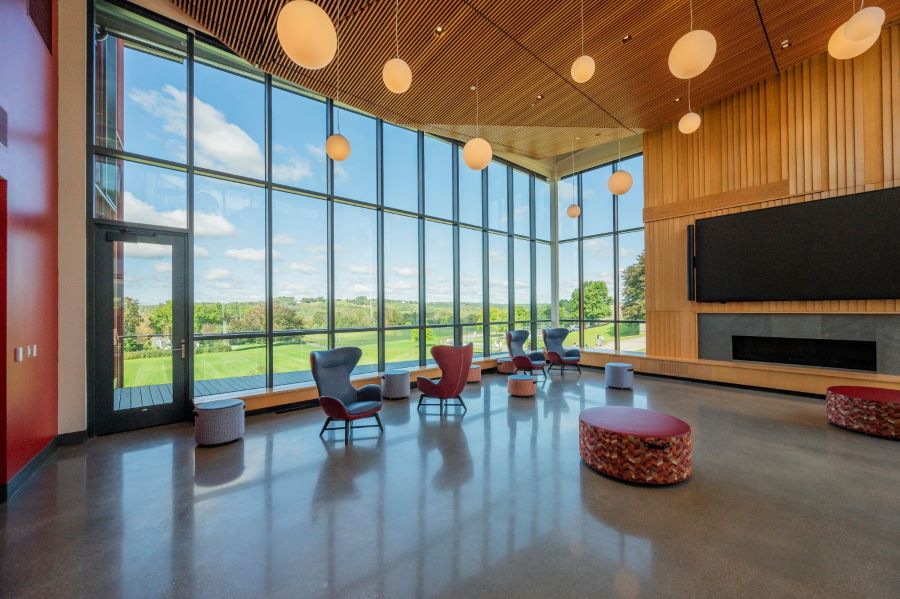Architectural Metals
Manufacturers and suppliers face a shifting supply landscape

Above: 110 East is a new transit-oriented office building located in downtown Charlotte, North Carolina. The façade was designed to pay tribute to the area’s industrial past, featuring a combination of glass vertical fins and horizontal bands that evoke a “woven” texture that references the former textile manufacturing sector of Charlotte’s South End. The building’s design also focused on performance, using YKK AP’s YWW 60 TU SSG Window Wall system and YCW 750 SSG Curtain Wall System, aiming to enhance occupant comfort and energy-efficiency. Photo by Mike Anthony.
Architectural metals are critical components for glazing systems and fenestration. Like many in the construction industry, architectural metal manufacturers, fabricators and suppliers have been facing a new economic landscape in the last year, which has re-shaped material supply in the present, and potentially, the future as well.
A new tariff environment and new expectations for sourcing
In late February 2025, U.S. President Donald Trump reinstated Section 232 tariffs on aluminum and steel at 25% after ending some of the exceptions made under the Biden administration, later doubling the rate to 50% in June. The 232 statute empowers the president to adjust imports to protect national security, following an investigation and recommendations from the U.S. Secretary of Commerce. Other goods, outside of steel and aluminum, have also been subject to the International Emergency Economic Powers Act, or IIEPA, tariffs and reciprocal tariffs. Most aluminum goods do not have “stacked” tariffs, meaning they are not subject to more than one type, according to the Aluminum Extruders Council.
A major exception is Chinese aluminum and steel, which also receive Section 301 tariffs, imposed in 2018 and continued through the Biden administration. The taxes are imposed under Section 301 of the Trade Act of 1974, which allows the United States Trade Representative to investigate unjust foreign trade practices.
The new tariff environment has impacted metal products suppliers in a variety of ways, industry leaders say. “Cost volatility and lead-time assurance across aluminum, glass and hardware inputs are definitely top of mind,” says Tammy Schroeder, director of marketing, Apogee Architectural Metals.
Sarah Andreasen, director of North American sales at Kawneer, says the impact of tariffs have been varied. The company has reconsidered imported products used in manufacturing their systems, as well as reducing the impact from cross-border importing with the company’s assets in Canada. Despite the company having long-term contracts for billet supply, the changing premiums on billet pose a challenge. “We have some mechanisms that we can use to plan for those changes, to try to bear it out as long as we can, but at some point, must take additional actions to help offset the impact of the increases.”
“Tariffs have introduced a lot of uncertainty into the market, which has changed how customers plan and buy,” says Armando Rodriguez, vice president of manufacturing, Frameless Hardware Co. “We’re seeing more customers procure materials earlier than usual to lock in pricing before potential increases, and many request updated quotes right before placing orders to stay ahead of fluctuations.”
Tommy Williams, a representative for PAC-CLAD Petersen, says that while the new economic environment has created “uncertainty,” it has also created opportunities to connect with customers. “I’ve observed that the tariffs have created better communication and planning between customers and vendors, and as a manufacturer, I always welcome more communication with our customers.”
Describing the overall market as “tight,” Tom O’Malley, managing partner of Clover Architectural Products, recommends that companies continue to diversify to expand revenue. “For Clover, we added some new products like interior fin tube covers and grilles,” he says.
Mike Turner, president of YKK AP’s commercial business group, describes the market as “stable,” but cautions that the tariffs may encourage countries exporting aluminum to the U.S. to sell to other markets. Additionally, he says tariffs could work as a “double-edged sword” if domestic demand rebounds while supply remains low. “If the market gets hot again, then the tariff also increases, because the tariff is [calculated based on a percentage of] the value of the aluminum. So, the higher the value on the product, the higher the tariff.”
Tariff and Legislative Terms
Section 232 tariffs: Section 232 of the Trade Expansion Act of 1962 empowers the president to restrict or impose limits on imported goods or adjust trade partnerships if, following an investigation, the Secretary of Commerce feels the situation could affect U.S. national security.
Section 301 tariffs: Section 301 of the Trade Act of 1974 allows the United States Trade Representative to investigate and impose restrictions, including tariffs, related to foreign trade practices.
Buy America Act, 1982: Part of the Surface Transportation Assistance Act, the Act set guidelines for purchasing American-made products for projects receiving federal funding.
Build America, Buy America (BABA), 2021: Expanded the domestic-sourcing requirements of the Buy America Act in 1982 from projects receiving grants, to all federal financial assistance programs for infrastructure.

Implications for Build America, Buy America and the aluminum supply chain
In addition to tariffs, manufacturers and suppliers working with architectural metals say they’re also seeing a rising interest in domestically sourced products. “We have seen an increase in compliance requests and more of an emphasis on American-made products,” says Josh Wignall, chief marketing officer, Quaker Windows & Doors.
“We’ve seen a noticeable increase in requests for Buy American and [Build America, Buy America]-compliant products across our projects,” says FHC’s Rodriguez. “This makes it more important than ever to review specifications carefully and understand each project’s unique requirements.” Some leaders reported seeing this increase on institutional building and government-funded projects.
As Glass Magazine contributor Mary Avery, former senior director of product management for Tubelite, Alumicor, EFCO and Linetec brands, explained in her 2024 article, “Demystifying the Build America, Buy America Act,” the original Buy American Act of 1933 was one of the first pieces of legislation to require materials be manufactured in the U.S. Decades later, the similarly named Buy America Act was passed in 1982 as part of the Surface Transportation Assistance Act, which set preference guidelines for purchasing American-made products for projects receiving federal grants, like highways. “With BA, the definition of ‘American-made’ was expanded to mean that all steel and iron components of end products must be mined, melted and manufactured in the U.S.,” Avery says.
Build America, Buy America—signed into law by former U.S. President Joe Biden in 2021—then expanded the requirements of the Buy American Act, applying its standards “to all federal financial assistance programs for infrastructure,” Avery explains. One of the consequences for those supplying aluminum fenestration, she says, is that primary and secondary aluminum billet must be smelted/melted in the U.S.
John McClatchey, vice president of marketing for Southern Aluminum Finishing, says that the company is working to educate themselves and their customers about the difference between the Buy American Act and the more recent BABA. The difficulty, from his perspective, is that customers working on projects requiring BABA compliance are asking SAF to ensure materials are domestically sourced, which is not possible for all aluminum alloys supplied by the company.

As Canadian aluminum imports are strained, expanded domestic supply is on the horizon
The aluminum production landscape in the U.S. has changed dramatically over the last quarter of a century. Since 2000, the number of aluminum smelters—where primary aluminum is produced from smelted alumina—dropped from 24 to four. Today, only 16% of the primary aluminum used in the U.S. is produced domestically, says Mike Turner of YKK AP. Canada, which has nine smelters owned by three producers, exports 93% of its primary aluminum to the U.S. according to the Aluminium Association of Canada. The Aluminum Association reports that Canadian imports represent two-thirds of America’s supply of primary aluminum, as of February.
Canada’s lower energy costs are part of the reason so much primary aluminum is imported from the country. Onshoring primary aluminum production to the U.S. is a possibility, though it would require more affordable energy, according to the Aluminum Association. Building new smelters would require a lead time of five to six years, they say, and bringing the existing four smelters up to full capacity would also be a longer-term project.
Two aluminum production companies have proposed expanding production capacity in the U.S. In March 2024, Century Aluminum Co., the largest primary aluminum producer in the U.S., announced that it had been selected by the U.S. Department of Energy to receive an award for the construction of a new aluminum smelter, the first to be built in the U.S. in 45 years. At the time of the announcement, Century proposed to build near the Ohio and Mississippi River basins, possibly in Kentucky, according to local reporting at the beginning of 2025. In August, the company announced that it would also be restarting its plant in Mt. Holly, South Carolina, which had been operating at 75% capacity. At full capacity, company leadership say they expect the smelter to have an economic impact of over $890 million in the state.
Century Aluminum CEO Jesse Gary said the decision was a direct result of the new Section 232 tariffs. “Our team stands ready to continue leading the resurgence of domestic primary aluminum, starting with bringing our Mt. Holly smelter back to full production,” he said in a statement.
Emirates Global Aluminium, a global aluminum producer, also announced plans to open a new plant in Oklahoma. Construction was planned to be completed by the end of 2026, with the first metal produced by the end of the decade.
SAF’s McClatchey says that the push for a domestic aluminum supply should also involve expanded aluminum recycling infrastructure. “We can be aluminum independent if we just had a more robust recycling environment in the U.S. Aluminum is 100% renewable, recyclable and it takes 5% of the energy to recycle it as it does to smelt it.”
Performance, Lack of Labor Continues to Drive Product Development
Outside of tariff and sourcing considerations, a variety of factors continue to shape product selection and development for metal systems. Kawneer’s Andreasen says that customers are asking for code-driven solutions, including “continued improvement” in thermal performance, as well as resiliency. Hurricane impact requirements “that were once very regional are spreading” up the East Coast, she says.
Prefabrication and unitization continue to trend as well, industry leaders say. “There’s still a very strong focus on doing as much work in a controlled shop environment,” says Clay Wilhoite, project center operations manager at YKK AP. Clover’s O’Malley says that unitization can depend on the city where the work is happening, as well as labor costs. “Obviously each market is different and has different labor rates. For some cities, unitizing is not as much of an advantage as others. When you get into New York, Boston, Chicago, San Francisco and other large cities, the more unitized the better,” he says.
Industry leaders say that sustainability is still shaping product demands, especially from the design community. “Owners and architects are placing a much stronger emphasis on sustainability, requesting Environmental Product Declarations and full material transparency documentation. We’re also seeing rising demand for low-carbon materials, and products with recycled content,” says Mike Mendoza, director of business development at Sightline Commercial Solutions.
“We’re continuing to see enthusiastic attention for products delivering high levels of energy efficiency, including superior thermal and wind load performance, as well as improved air infiltration resistance,” says Matt Gyore, technical director, CRL.
“Product development in metal coatings and finishes is being driven by a clear and growing demand for sustainability attributes,” says Jeff Bonez, sales director of extrusion coatings for Sherwin-Williams, which includes a range of considerations, including the expected carbon footprint reduction, as well as use of recycled ingredients, waste reduction and VOC reduction, among many factors. Apogee’s Schroeder says she expects that the interest in EPDs, Declare labels and other material transparency measures will grow in the coming years.


